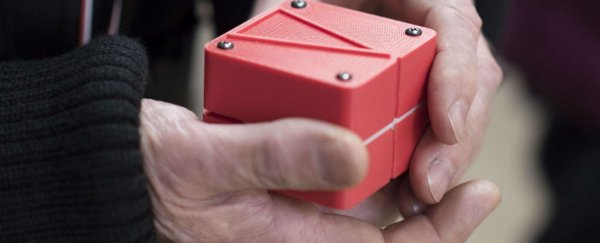Smartphones and sat navs have revolutionised the way we find our way around strange places - or just from A to B - but what happens if you can't see a mobile device display? Yale University robotics graduate Adam Spiers has come up with a new gadget that enables its users to 'feel' their way around an environment: it uses changes in its shape to help guide people to their destination through touch alone.
The Animotus sits in the palm of your hand and rotates left and right to point you in the right direction. It also extends forward to varying degrees, based on how far you've still got to travel, retracting as you go. "The simple idea is that when you've arrived at your target destination, it becomes a little cube again," says Spiers.
A London-based interactive presentation called Flatland was responsible for bringing the Animotus into reality. Set in an old church and based on Edwin A. Abbott's 1884 story of a completely two-dimensional world, the production asked audience members to use a 3D-printed cube to help them find their way around the set. A spoken narrative and sound effects were used to tell the story.
After some trial and error, Spiers was able to settle on a final design, eschewing any use of vibrations or audio cues, which he says had the potential to be too distracting. There are no fixed plans to expand the reach of the Animotus, but its creator is open to the possibility: "I'd like to try this out for the outdoors - hook it up to Google Maps and see what happens," he says.
In the production of Flatland at least, the device proved to be a complete success, with users walking only slightly slower than they normally would as they moved around despite the darkness and the unfamiliar technology. Spiers reports that audience members were sad to give up their Animotus gadgets at the end of the show.
There's a short video showing the device in action below, and it's received funding from Nesta, a UK-based charity supporting innovation. If it's to be used in the real world, the Animotus will need to integrate some form of GPS sensor - the current version uses wireless sensors mounted on the walls of the environment it's set in.
Several weird and wonderful bits of kit are in development to help visually impaired people find their way around using technology: from a smart headset that uses sound as a guidance system to the BrainPort V100, which draws a picture of the user's immediate environment on his or her tongue. If it can make the leap to a commercial product, the Animotus could be the cheapest and most straightforward device yet.
